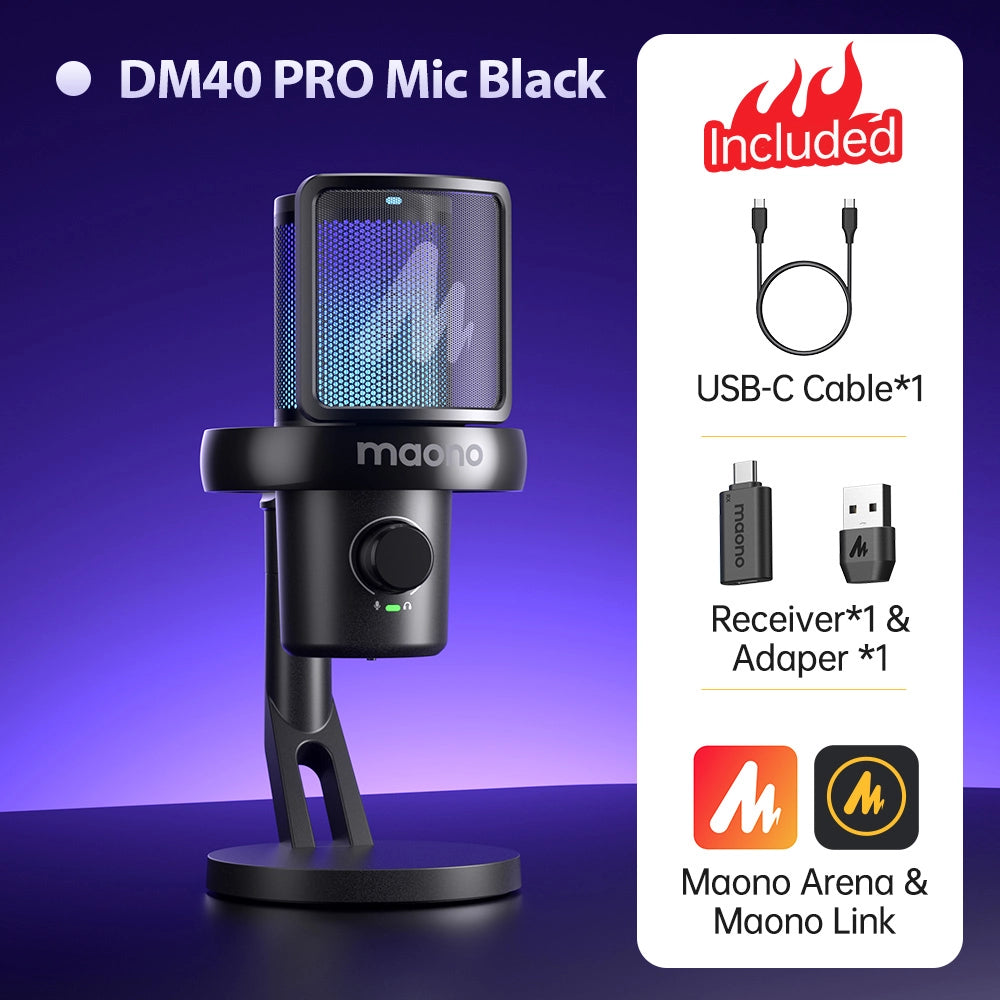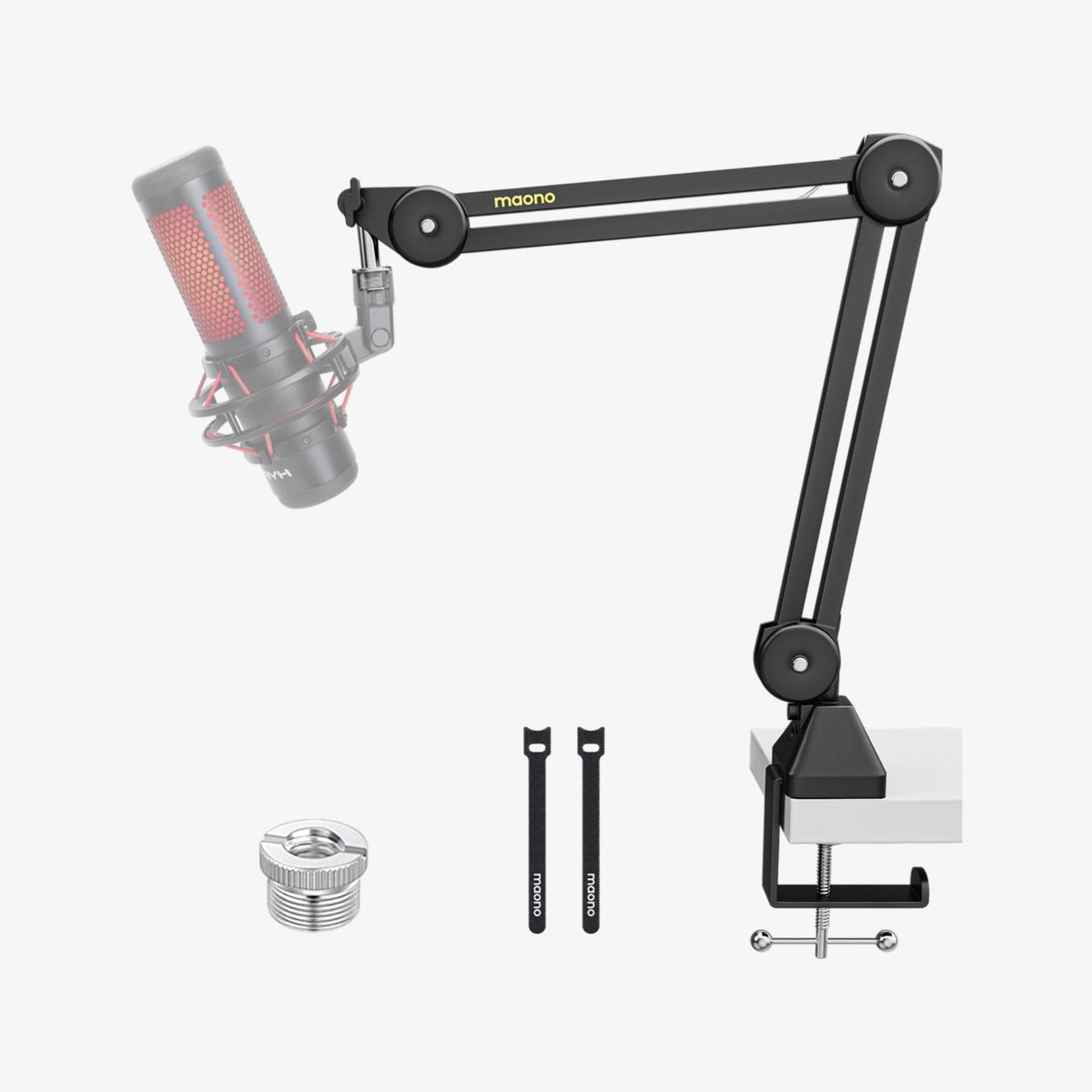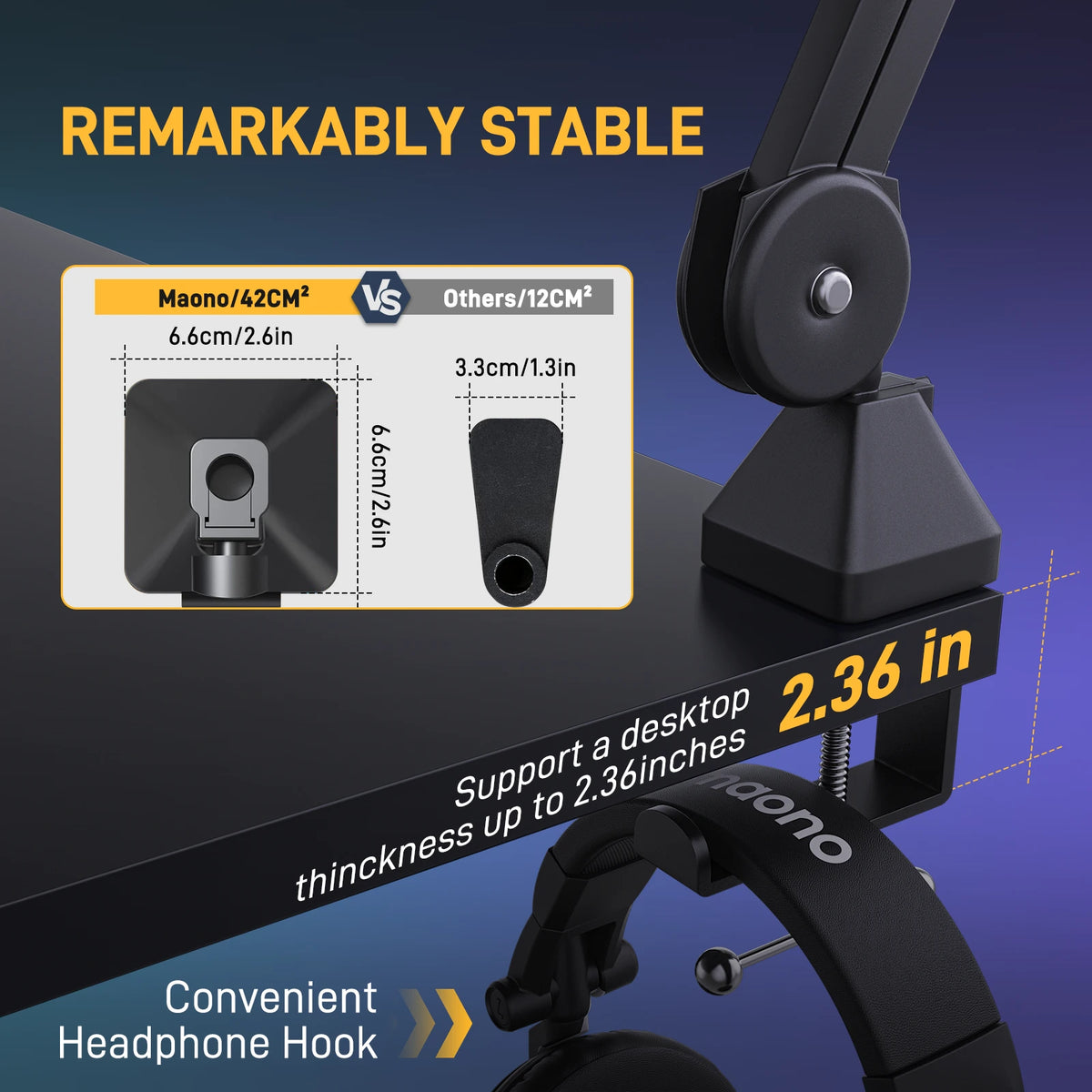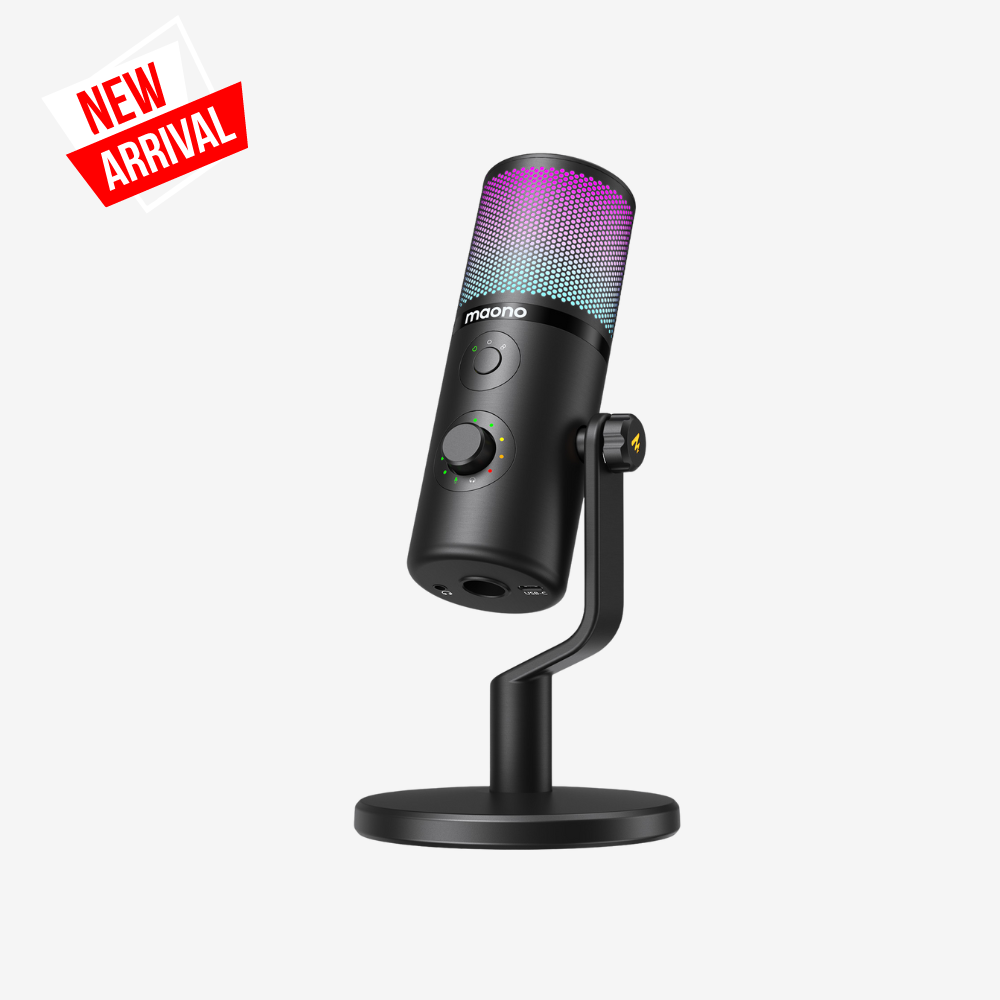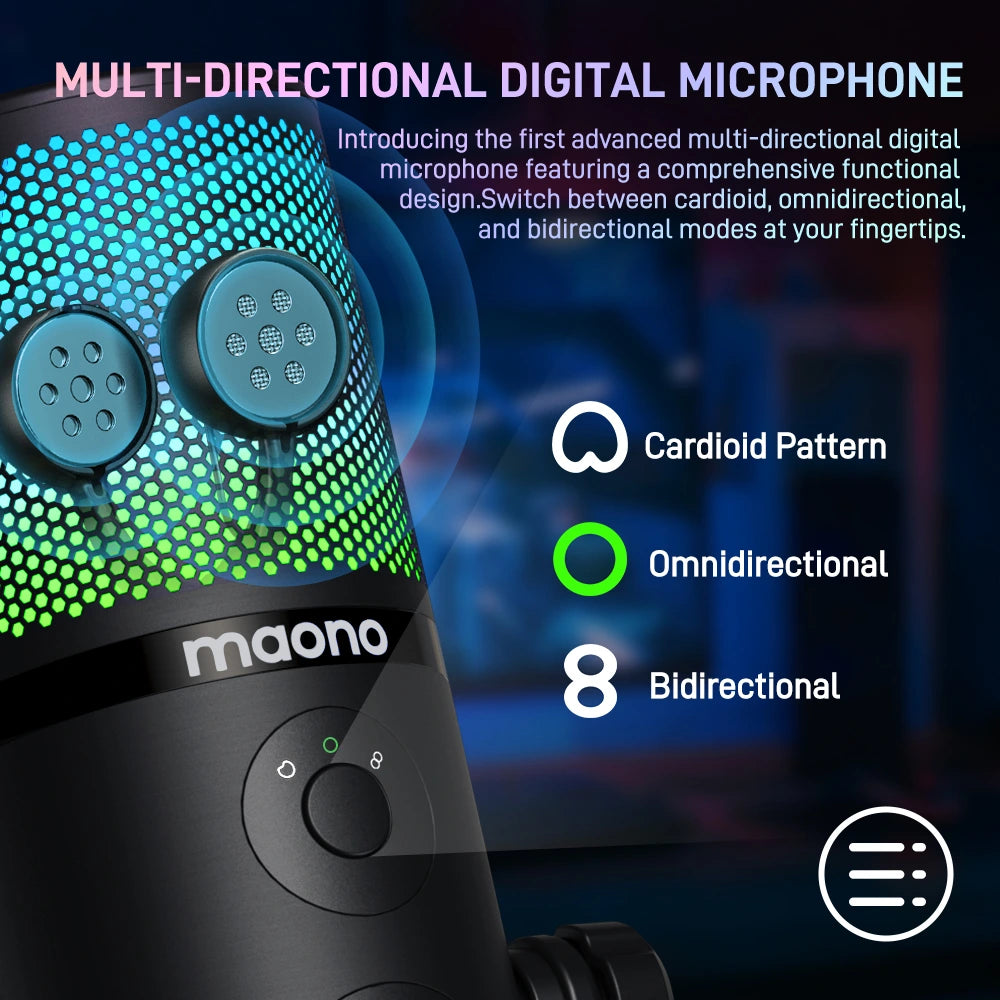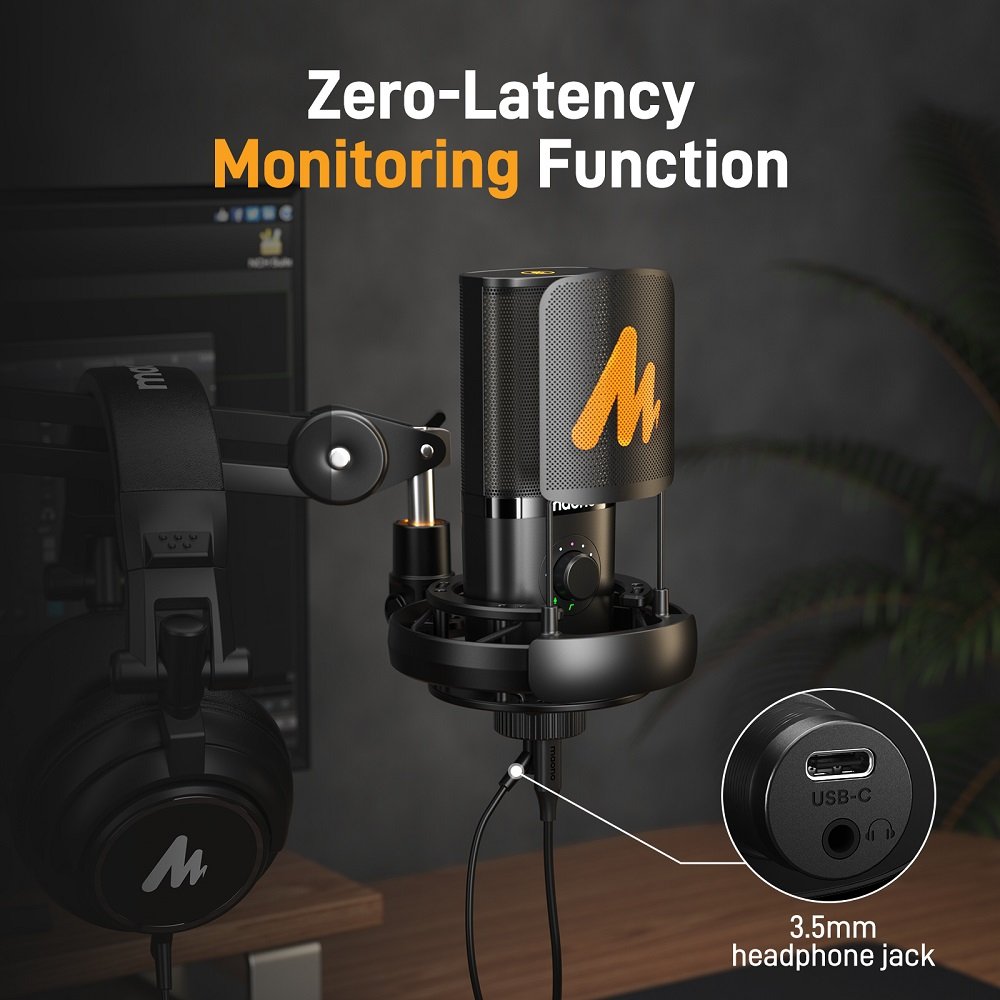A Clip-on Bluetooth Lavalier microphone is an excellent choice if you're looking for a convenient and wireless solution for clear audio. However, if durability is your main concern, you may prefer a wired lav microphone. In this guide, we'll walk you through choosing between a Bluetooth clip-on wireless lavalier microphone and a wired lav microphone to meet your audio requirements.
There are two types of lavalier microphones, wired and wireless.
Wired Lav Microphone vs. Wireless Lavalier Microphone
When it comes to choosing a lavalier microphone for professional settings, both wired and wireless options have their advantages and disadvantages. Here’s a quick comparison to help you decide which is best for your needs.
- Wired lavalier microphone
A wired lavalier mic comes with cables to connect with your recording device. It’s easy-to-use at an affordable price.
- Pros:
- Stable Connection: Wired microphones provide a reliable audio connection, free from interference.
- Consistent Sound Quality: Typically offer superior audio quality without the risk of dropouts.
- No Batteries Required: They don’t need batteries, eliminating the worry of power failure during use.
- Cons:
- Limited Mobility: The cable can restrict movement, making them less suitable for dynamic presentations.
- Tangle Issues: Cables can become tangled or caught on objects.
- Best Use Cases:
- Interviews: Ideal for controlled environments like interviews or podcasts where the speaker remains stationary.
- Film Production: Great for shoots where the mic needs to be discreet and stable
- Wireless lavalier microphone
A wireless lavalier microphone system includes a transmitter where the mic cable is plugged into and a receiver. It enables greater freedom of movement but is more expensive compared with the wired ones.
- Pros:
- Freedom of Movement: Wireless microphones allow speakers to move freely without being tethered.
- Flexible Setup: They can be positioned at varying distances from the recording device.
- Cons:
- Potential for Interference: Wireless signals can be disrupted by other devices, leading to audio issues.
- Batteries Required: Dependence on batteries means you need to keep them charged or have spares on hand.
- Best Use Cases:
- Live Performances: Perfect for stage performances or presentations where movement is essential.
- On-Location Filming: Useful in dynamic shooting environments where cable management is impractical.
Tips for Choosing Between Wired and Wireless Lavalier Microphone
When deciding between a wired and wireless lav microphone, consider these key features:
1. Audio Quality: If sound quality is your top priority (like in a studio setting), a wired lav might be the better choice.
2. Mobility Needs: If you need to move around frequently, opt for a wireless lav. Check the range specifications to ensure it meets your requirements.
3. Battery Life: For long events or shoots, consider wireless options with extended battery life or those that offer quick charging.
4. Environment: In a crowded or interference-heavy space, a wired lav might be more reliable. In contrast, a wireless lav with frequency diversity can help reduce interference.
5. Budget: Wired microphones tend to be more affordable, while high-quality wireless systems can be a significant investment.
Final Tips:
- Test Before Use: Always test your equipment before the event to ensure everything works as expected.
- Have Backup Options: If possible, bring both types to an event to prepare for different scenarios.
- Research Brands: Look for reputable brands known for durability and quality in both wired and wireless options.
Now that you know what a wired lav microphone is and when to use it, let’s move on to knowing more about a Bluetooth clip-on microphone.
This time let's explore the similarities and difference of a traditional wireless Lavalier microphone and the Bluetooth Lavalier microphone
Here's a Comparison Table:


What is a Bluetooth Clip-On Mic?
A Bluetooth clip-on mic is a wireless microphone that you may wear on your clothes, like a lapel or collar, and it uses Bluetooth technology to send audio wirelessly to a device that is connected. It is intended to provide a practical hands-free audio solution, especially for communication or recording needs.
How to Use a Bluetooth Clip-On Lavalier Microphone?
Step 1. Unbox and Charge
- Unboxing: Remove the microphone, charging cable, and any additional accessories from the packaging.
- Charging: Connect the microphone to a power source using the included USB cable. Fully charge the device according to the manufacturer’s instructions, usually indicated by a LED light that changes color or turns off when fully charged.
Step 2. Pairing the Microphone
- Power On: Turn on the Bluetooth lavalier microphone. There’s often a dedicated power button; check for an LED indicator to confirm it’s powered on.
- Pairing Mode: Enable pairing mode on the microphone. This is typically done by holding down the power button for a few seconds until the LED starts blinking, indicating it's in pairing mode.
- Connect to Device: On your smartphone, tablet, or computer, go to the Bluetooth settings and search for new devices. Select the microphone from the list of available devices to pair. You might need to confirm the pairing or enter a code if prompted.
Step 3. Attach the Microphone
- Clip-On: Secure the microphone to your clothing, ideally near your collar or lapel, for optimal sound quality. Ensure the microphone is not too close to your mouth or too far from it.
- Positioning: Aim the microphone’s capsule towards your mouth for clear audio capture. Make sure the clip is fastened properly to prevent rustling sounds from loose clothing.
Step 4. Test and Adjust
- Check Audio Levels: Open your recording or communication app and check if the audio from the microphone is being picked up correctly. Some devices have a setting to select the input source; make sure your Bluetooth microphone is selected.
- Adjust Settings: If available, adjust the microphone settings in your app or device to enhance audio quality. You might be able to adjust gain levels or enable noise reduction features.
Step 5. Use and Maintain
- Usage: During use, avoid touching or moving the microphone excessively to minimize noise interference. Ensure the microphone stays within the effective range of your device’s Bluetooth connection.
- Storage and Care: When not in use, turn off the microphone to conserve battery life. Store it in a safe, dry place to prevent damage.
- Connection Issues: If you have trouble connecting, ensure your device’s Bluetooth is turned on and not paired with another device. Restart both the microphone and your device if necessary.
- Audio Problems: If the sound quality is poor, check for obstructions, ensure proper positioning, and verify that no other applications are interfering with the microphone input.
Benefits of Using a Clip-On Lavalier Microphone for Wireless Setup
1. Wireless Freedom and Mobility
- No Cables: Bluetooth lavalier mics eliminate the need for physical cables, allowing you to move freely without being tethered to your recording device. This is particularly useful for presenters, performers, and content creators who need to move around or adjust their position.
- Flexible Use: Ideal for dynamic environments where mobility is essential, such as live performances, public speaking engagements, and on-the-go interviews.
2. Ease of Setup and Use
- Quick Pairing: Modern Bluetooth lavalier microphones are designed for easy pairing with smartphones, tablets, and computers. Setup typically involves simple Bluetooth pairing, without the need for additional adapters or complicated installations.
- Convenient Operation: Many models are user-friendly, featuring intuitive controls for power, volume, and pairing, making them accessible even for users who may not be tech-savvy.
3. Compact and Discreet Design
- Minimalist Aesthetics: The compact size of Bluetooth clip-on mics allows them to be easily clipped onto clothing, making them less obtrusive than larger microphone setups. This discreet design is ideal for professional settings, interviews, and video production where appearance and simplicity matter.
- Portability: Lightweight and small, these mics are easy to carry and store, making them a great choice for travel or fieldwork.
4. Improved Audio Quality
- Enhanced Clarity: Many Bluetooth lavalier mics are designed to capture clear, high-quality audio with minimal background noise. They often feature built-in noise reduction and echo cancellation technologies.
- Consistent Sound: With proper placement, these mics can provide consistent sound quality, especially when used in controlled environments like studios or quiet rooms.
5. Versatile Applications
- Content Creation: Perfect for vloggers, podcasters, and video creators who need high-quality audio while moving around or changing positions. They allow for flexible recording setups without the constraints of cables.
- Public Speaking and Presentations: Useful for speakers and presenters who need to engage with their audience without being hindered by wired connections.
- Interviews: Ideal for journalists and interviewers who need a portable and unobtrusive solution for capturing clear audio in various settings.
Additional Considerations:
- Battery-Powered: While they require regular charging, many Bluetooth lavalier mics offer long battery life, providing hours of use on a single charge.
- Easy Storage: Their compact nature makes them easy to pack and transport, especially when traveling for work or events.
Common Issues with Wireless Microphones and How to Troubleshoot Them
Wireless microphones offer great convenience and flexibility, but they can encounter several potential issues. Here’s a discussion of common problems, particularly signal interference, along with troubleshooting tips:
1. Signal Interference
- Description: Wireless microphones operate on specific radio frequencies. Interference can occur from other wireless devices, such as Wi-Fi routers, mobile phones, or other microphones operating on the same frequency.
- Troubleshooting:
- Change Frequencies: If your microphone allows, switch to a different frequency or channel that is less congested. Many modern wireless systems come with multiple frequency options.
- Positioning: Keep the transmitter and receiver as close as possible, and avoid physical barriers. Adjust the microphone's position to reduce obstruction and interference.
2. Dropouts and Static
- Description: This occurs when the signal is weak or interrupted, leading to audio dropouts or static noise in the transmission.
- Troubleshooting:
- Check Batteries: Ensure that both the transmitter and receiver have fully charged batteries. Weak batteries can lead to dropouts.
- Distance: Maintain an appropriate distance between the transmitter and receiver. Too much distance can weaken the signal.
3. Audio Quality Issues
- Description: Poor audio quality can arise due to low battery levels, incorrect gain settings, or interference.
- Troubleshooting:
- Gain Settings: Adjust the gain on the transmitter and receiver to ensure optimal audio levels. Too high can cause distortion, while too low may result in weak audio.
- Test Before Use: Always conduct a sound check before the event to identify any quality issues.
4. Environmental Factors
- Description: Physical obstructions, such as walls or metal objects, can block the signal, especially in complex environments like concert halls or urban areas.
- Troubleshooting:
- Clear Line of Sight: Position the receiver in a location that has a clear line of sight to the transmitter. Avoid placing the receiver behind large objects or in corners.
- Use Antenna Boosters: Consider using antennas or signal boosters designed to enhance reception.
5. Compatibility Issues
- Description: Not all wireless microphones are compatible with all devices, leading to connection problems.
- Troubleshooting:
- Check Compatibility: Before purchasing, ensure that the microphone is compatible with your recording or amplification system.
- Update Firmware: If applicable, check for firmware updates for your wireless system that might improve compatibility and performance.
6. Intermittent Connection
- Description: This issue can arise if the transmitter and receiver are not properly paired or if there are obstacles interfering with the signal.
- Troubleshooting:
- Re-Pair the Devices: Follow the manufacturer’s instructions to reset and re-pair the transmitter and receiver.
- Check for Obstructions: Ensure there are no objects between the transmitter and receiver that could disrupt the signal.
Preventive Measures
- Frequency Scanning: Use wireless systems that come with scanning features to automatically select the clearest frequency before use.
- Regular Maintenance: Regularly check and replace batteries, clean connections, and ensure all equipment is functioning correctly.
- Practice and Familiarization: Familiarize yourself with your wireless system’s features and troubleshooting steps before important events.
Being aware of these potential issues and knowing how to troubleshoot them can that users ensure a smoother experience with their wireless microphones, leading to better audio quality and overall performance.
Top 5 Clip-On Bluetooth Lavalier Microphones
Here are the top 5 examples of Bluetooth clip-on microphones that are popular for their performance, quality, and ease of use:
1. Rode Wireless GO II
Features:
- Dual-channel wireless system
- Compact and lightweight design
- Built-in microphone and USB-C connectivity
- Up to 200 meters (656 feet) range
- Long battery life with up to 7 hours of operation
- Ideal For: Vlogging, interviews, and content creation
2. Sennheiser XSW-D Portable Lavalier Set
Features:
- Digital wireless transmission
- Easy setup with one-touch pairing
- High-quality lavalier microphone included
- Up to 75 meters (246 feet) range
- Long battery life with up to 5 hours of operation
- Ideal For: Presentations, interviews, and video production
3. Sony ECM-AW4
Features:
- Wireless Bluetooth lavalier microphone
- Compact and lightweight design
- Up to 150 meters (492 feet) range
- Includes receiver and transmitter
- Rechargeable battery with up to 8 hours of use
- Ideal For: Business meetings, video recording, and public speaking
4. Comica CVM-WM100 Plus
Features:
- UHF wireless microphone system with Bluetooth capabilities
- Up to 100 meters (328 feet) range
- Real-time monitoring with headphone jack
- High-fidelity audio capture
- Includes two transmitters and one receiver
- Ideal For: Professional video production and interviews
5. BOYA BY-WM4 Pro K2
Features:
- Compact wireless microphone system.
- Bluetooth connectivity with a receiver and transmitter.
- Includes lavalier microphones and accessories.
- Up to 60 meters (197 feet) range.
- Rechargeable battery with up to 8 hours of usage.
- Ideal For: Content creators, vloggers, and mobile recording.
Maono Wireless Lavalier Microphone Recommendations:
Maono WM820 A1/A2 Compact Wireless Microphone System
Mic Type: Lavalier Clip-On Microphone
Frequency Response:
Typically around 50 Hz to 20 kHz (general range for similar models)
Polar Pattern:
Omnidirectional (captures sound equally from all directions around the mic)
Sampling Rate:
Generally, wireless systems like this are designed for real-time audio transmission, and specific sampling rates are not always listed but are typically aligned with Bluetooth or digital wireless transmission standards.
Sensitivity:
Approximate sensitivity is around -42 dB (varies by exact model and setup)
Notable Features:
✅ Compact Design: Small and lightweight, making it easy to clip onto clothing.
✅ Wireless Transmission: Operates wirelessly, providing freedom of movement.
✅ Long Battery Life: Offers extended use on a single charge.
✅ Easy Pairing: Simple Bluetooth or digital pairing with receiving devices.
✅ Built-In Microphone: Includes a built-in mic or an external lavalier mic.
The Maono WM820 A1/A2 is a versatile and compact wireless microphone system designed to provide clear audio capture with the convenience of wireless operation. It’s ideal for users who need reliable audio transmission without the constraints of cables.
Scenarios to Use/Ideal For:
- Content Creation: Ideal for vloggers, YouTubers, and podcasters needing a portable, high-quality audio solution.
- Public Speaking: Suitable for presentations and speeches where freedom of movement is required.
- Interviews: Useful for interviews in various settings where a discreet, wireless mic is beneficial.

Maono WM620 Lavalier Wireless Microphone
Mic Type: Lavalier Clip-On Microphone
Frequency Response:
Typically around 20 Hz to 20 kHz (general range for similar models)
Polar Pattern:
Omnidirectional (captures sound from all directions)
Sampling Rate:
Like many wireless microphones, it may not explicitly list a sampling rate but is designed for real-time audio capture consistent with Bluetooth or digital wireless standards.
Sensitivity:
Approximate sensitivity is around -42 dB (varies slightly by model)
Notable Features:
✅ Compact and Lightweight: Designed to be discreet and easy to wear.
✅ Wireless Operation: Provides the freedom to move without being tethered by cables.
✅ Rechargeable Battery: Features a built-in battery with substantial operating time on a single charge.
✅ Clip-On Design: Includes a clip for easy attachment to clothing.
✅ Easy Setup: Simple wireless pairing with compatible devices.
The Maono WM620 is a reliable wireless lavalier microphone that offers a compact design and excellent audio quality. It is designed for users who need a portable and convenient microphone solution with the benefit of wireless freedom.
Scenarios to Use/Ideal For:
1. Broadcasting and Content Creation: Perfect for video creators, streamers, and podcasters who need high-quality audio without the hassle of wires.
2. Presentations and Lectures: Suitable for speakers and educators who need a hands-free microphone that allows for mobility.
Interviews and On-the-Go Recording: Useful for journalists and interviewers requiring a compact and wireless solution for capturing clear audio.
Tips for Getting the Best Sound Quality from Your Bluetooth Lavalier Mic
To ensure you get the best sound quality from your Bluetooth lavalier microphone, consider these five tips:
1. Proper Placement and Positioning

- Clip Placement: Attach the microphone to a stable part of your clothing, such as the collar or lapel, about 6-8 inches from your mouth. Ensure it's positioned to capture your voice clearly while avoiding rustling sounds from clothing.
- Avoid Obstacles: Place the mic where it’s less likely to pick up background noise or be obstructed by clothing or accessories. Keep it at a consistent distance from your mouth for optimal audio clarity.
2. Optimize Bluetooth Connectivity
- Pairing and Range: Ensure your microphone is properly paired with your recording device and within the effective Bluetooth range. Avoid physical obstructions and interference that might disrupt the signal.
- Minimize Interference: Keep the microphone and the paired device close to avoid potential signal interference from other electronic devices or objects.
3. Monitor and Adjust Audio Settings
- Gain Levels: Adjust the gain levels on your recording device or app to avoid clipping (distortion caused by overly loud sounds) and ensure clear audio capture. Test and adjust these levels before starting your main recording.
- Noise Reduction: If available, enable noise reduction or suppression features in your recording app or device settings to minimize background noise and enhance voice clarity.
4. Check and Maintain Battery Life
- Charge Regularly: Ensure the microphone’s battery is fully charged before use. Regularly monitor battery levels to avoid interruptions during important recordings or presentations.
- Spare Battery: Consider keeping a spare battery or power bank handy if your microphone supports external charging or if long sessions are planned.
5. Perform Regular Maintenance
Clean the Mic: Keep the microphone clean and free from dust or debris that could affect sound quality. Use a soft brush or a cloth to gently clean the mic head and the clip.
Test Before Use: Always test the microphone before important recordings or presentations. Check for any issues with sound quality, connectivity, or battery life to ensure everything is functioning correctly.
FAQs:
1. How often do you need to replace or recharge the batteries for a wired lav microphone? How about for a wireless lav microphone?
- Wired Lavalier Microphone: Wired lav mics do not require batteries, as they connect directly to the recording device. Therefore, you won’t need to replace or recharge anything for the microphone itself.
- Wireless Lavalier Microphone: The frequency of battery replacement or recharging depends on the specific model and usage. Most wireless lav mics use rechargeable batteries, which can last anywhere from 6 to 20 hours on a full charge. It's a good practice to charge them after each use and have spare batteries available for longer events.
2. What features do you value most when choosing a wireless lavalier microphone?
When selecting a wireless lavalier microphone, consider these key features:
- Battery Life: Long-lasting batteries are crucial, especially for events or shoots that extend over several hours.
- Range: Look for a system with a good transmission range, ideally 100 feet or more, to accommodate various setups.
- Sound Quality: Ensure the microphone delivers clear, high-quality audio without interference or distortion.
- Frequency Diversity: This feature helps minimize interference by automatically switching frequencies, providing a more reliable connection.
- Build Quality: Durable construction is essential, especially for on-the-go use. Look for weather-resistant designs if you'll be in outdoor environments.
- Ease of Use: Simple setup and pairing processes can save time during events.
3. How do you find the durability and build quality of a wired lav microphone and a wireless lav microphone?
- Wired Lavalier Microphone: Generally, wired lav mics have robust designs, especially those made with high-quality materials. The cable can be a weak point, so look for models with reinforced connectors and durable cables to prevent wear and tear.
- Wireless Lavalier Microphone: Durability can vary widely among wireless models. Higher-end wireless mics often have rugged, professional-grade construction that withstands frequent use and harsh conditions. It’s important to read reviews and check specifications to ensure they can handle your intended use.
4. What are the best wireless clip-on microphones for interviews?
Some of the top wireless clip-on microphones for interviews include:
- Rode Wireless GO II: Known for its compact size and high-quality audio, it features dual-channel recording, making it ideal for interviews with multiple speakers.
- Sennheiser EW 112P G4: A professional-grade system that provides excellent sound quality and reliable wireless performance, perfect for on-the-go interviews.
- Shure MV88+ Video Kit: This versatile microphone includes a wireless transmitter and is great for both interviews and content creation, offering high-quality audio and easy connectivity.
- Maono WM820: A budget-friendly option that still delivers good sound quality, making it suitable for beginners conducting interviews.
5. How do I maintain my wireless lavalier microphone?
To maintain your wireless lavalier microphone:
- Regular Cleaning: Gently clean the microphone head with a soft, dry cloth to remove dust and debris. Avoid using harsh chemicals.
- Check Connections: Regularly inspect the cables and connectors for any signs of wear or damage, and replace them if necessary.
- Battery Management: Always keep an eye on battery levels. Use fresh batteries before important recordings and consider using rechargeable batteries for convenience.
- Storage: Store the microphone in a protective case when not in use to prevent physical damage.
- Test Before Use: Always conduct a sound check prior to your recording session to ensure everything is functioning properly.
6. Are wireless lavalier microphones worth the investment?
Yes, wireless lavalier microphones are generally worth the investment, especially for certain use cases:
- Freedom of Movement: Wireless microphones allow for greater mobility, which is essential for interviews, presentations, and on-the-go filming.
- Improved Audio Quality: Many wireless lavalier systems provide high-quality sound, enhancing the overall audio experience for your audience.
- Convenience: The ease of setup and use makes them ideal for various applications, from professional video production to casual vlogging.
- Professional Appearance: Using a wireless mic can enhance the professionalism of your content, making it more appealing to viewers and listeners.
It depends on your DSLR camera's Bluetooth compatibility. Most DSLR cameras do not have built-in Bluetooth audio support, so you'll need an additional Bluetooth transmitter or an adapter to connect the Bluetooth Lavalier microphone to your camera.
In conclusion, a Bluetooth clip-on microphone offers exceptional convenience and mobility by providing a wireless solution for clear audio capture. Unlike wired models, wireless lavalier microphones like these allow for greater freedom of movement and are ideal for various scenarios including content creation, public speaking, and interviews. By following the steps outlined and understanding the benefits of a Bluetooth clip-on mic, you can effectively enhance your audio recording experience. Interested in trying a wireless Lavalier clip-on mic? Check out our selection here for the best options.
Related Articles:
Stay Connected and Capture Every Word: Exploring the Benefits of Wireless Lavalier Microphones
How to Livestream on TikTok: Best Wireless Lavalier Mics & Setup Tips
Exploring Wireless Microphones: Different Types and Best Choices











